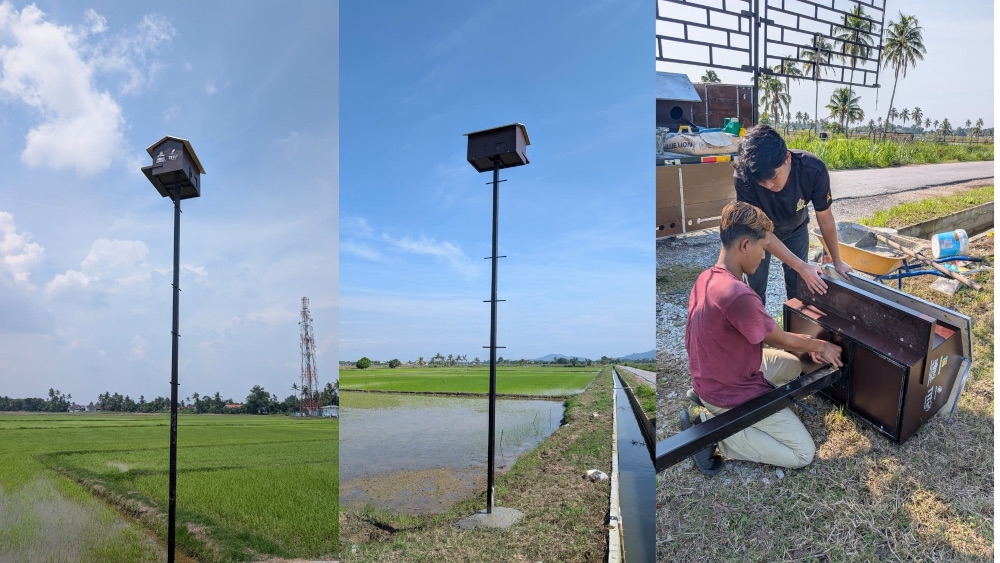GEORGE TOWN, May 21 — The Barn Owl and Rodent Research Group (Borg) of Universiti Sains Malaysia (USM) is pushing for a reduction in rodenticide use in plantations and fields to prevent secondary poisoning of other non-target species such as birds, fish, and reptiles.
Associate Professor Hasber Salim, who leads Borg, said some oil palm plantations and paddy farmers are using highly toxic second-generation rodenticides, which pose a threat to the natural predators of rodents, which includes the Asian barn owl.
“We are trying to encourage the conservation of barn owls as they can be implemented as biological control agents of rodents in oil palm plantations and paddy fields,” he said in an interview with Malay Mail.
An adult barn owl has a voracious appetite and can consume up to three rodents per night.
However, Hasber said secondary poisoning from ingesting rodents that have consumed second-generation rodenticides is one of the biggest threats to these owls.
“We have worked with various oil palm plantations and farms nationwide to introduce artificial nest boxes to attract barn owls to these places and to reduce the rodent population and reliance on rodenticides,” he said.
He added that corporations often refuse to stop using rodenticide, so Borg is hoping to push them to switch back to first generation rodenticides that are less toxic to the owls.
To note, first-generation rodenticides often require multiple feedings over several days to kill a rodent, whereas a second-generation dose is likely to kill in one feeding.
“Even after introducing barn owls to reduce the rodent population, we know they would not stop using rodenticide entirely so a compromise is to encourage them to use the less toxic rodenticides,” he said.

Trials and setbacks in owl conservation
Borg, established in 2014, has been studying barn owls and rodents in the past decade and has implemented multiple projects introducing the owls in various situations.
This included a project to introduce barn owls into urban settings to reduce rodent populations, specifically in Subang Jaya and around the USM campus.
“I would not say the project in Subang Jaya was a failure but we discovered that the bright moving lights of vehicles affected the sight of the owls’ sensitive eyes,” he said.
Furthermore, whenever people spotted the owls in the city, they chased after them and used flash photography that further frightened the owls, he added.
“Somehow, people get excited when they see the owls,” he said.
As for the project around USM grounds, Hasber said 20 artificial nest boxes were installed around the area, but only a small number of barn owls were attracted to live in them.
“We do not have a large population of barn owls here because of insufficient food for them,” he said.
In oil palm plantations and farms, the artificial nest boxes that Borg installs are often made of wood and placed on a stilt that is about 12 to 14 feet high.
“It has to be high enough so that people could not reach it and not too high that it could tip over when there is strong winds,” Hasber said.
At its aviary in USM, Borg has studied owlets that were rescued from nests where the mother owl was unable to feed all of its nestlings.
This allowed the group to learn about the growth, the habits and the diets of the owls up close before releasing the bird back into the wild.
“We let them learn to hunt rodents within the aviary and once we are confident that they can survive in the wild, we will release them in the paddy fields,” he said.
He said sometimes, people would find injured owls and bring them back to Borg to be rehabilitated and released once again.
Though Borg sometimes brings young barn owls out for exhibitions as part of educational campaigns to push for their conservation, he said the team is careful not to tame the owls.
“We do not want them to be tame because we plan to release them to the wild so that they can survive in the wild on their own,” he said.

Establishing barn owls in East Malaysia
The Asian barn owls are native to West Malaysia, but there used to be none in East Malaysia, so Borg conducted several projects to introduce the species there.
It took a few attempts, but they finally managed to translocate eight pairs of barn owls to Sabah about 10 years ago.
Hasber said translocating owlets from Peninsular Malaysia to Sabah does not work, as they would return due to a strong homing instinct.
“They are very smart creatures, so even if you bring them to another country, they will find their way back here,” he said.
So Borg devised a plan to bring eight pairs of owls to Sabah and breed them there, so that the owlets born in the location will consider it their home.
“It was successful as the owls, including the original eight pairs, continued to stay there and now, there are thousands of barn owls there,” he said.
Moving forward, he said Borg will continue to work with plantations and paddy farms to install more nest boxes to encourage the use of these natural pest-control instead of relying on rodenticides.
“Barn owls are the best method in sustainable farming that does not poison the environment or kill non-targeted species in the farms,” he said.
Recommended reading:




















